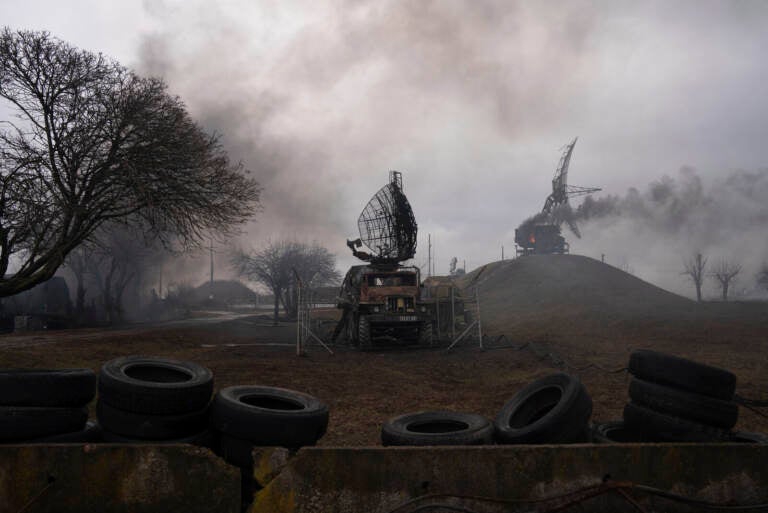In Ukraine, the road to war was paved by the failure of diplomacy

Smoke rise from an air defence base in the aftermath of an apparent Russian strike in Mariupol, Ukraine, Thursday, Feb. 24, 2022. (AP Photo/Evgeniy Maloletka)
As missiles rained down Thursday on Ukraine’s cities and Russian forces were reportedly making a blitz-like thrust for the capital, Kyiv, one thing was painfully clear: Weeks of marathon diplomatic efforts led by the U.S. had come to nothing.
After days of speculation about whether Russian President Vladimir Putin had made a final decision to invade, events earlier in the week left little room for doubt.
Putin signed agreements on Monday acknowledging the independence of the self-proclaimed Donetsk and Luhansk People’s Republics — carved out of eastern Ukraine as a result of a years-long separatist insurgency backed by Russia.
In an hourlong speech that followed, Putin sat at his desk in the Kremlin delivering a version of history in which democratic Ukraine was not a sovereign country, but a mere extension of Russia.

As an emergency meeting of the United Nations Security Council was taking place in New York on Wednesday evening, Putin announced Russia’s invasion and hostilities got underway.
Sergiy Kyslytsya, Ukraine’s U.N. ambassador, said the time to prevent war was over. “It’s too late, my dear colleagues, to speak about deescalation,” he said. “I call on every one of you to do everything possible to stop the war.”
Staring down his Russian counterpart, Kyslytsya proclaimed: “There is no purgatory for war criminals. They go straight to hell.”
Putin’s gamble follows months of heightened tensions and repeated warnings about an invasion, as the Kremlin pushed its long-standing demand that Ukraine never be allowed to join NATO.
Although Russia had repeatedly denied it was preparing to invade Ukraine, it was amassing as many as 190,000 Russian troops, along with tanks and artillery, in strategic positions along the border — in Belarus, which has close relations with Moscow, in Crimea, which the Kremlin illegally annexed in 2014 and near the Donbas region, where the separatist republics recognized by Putin on Monday are located.

Diplomatic efforts failed to prevent the invasion
The invasion of Ukraine followed a series of failed diplomatic efforts.
In December, Biden met virtually with Putin in what the White House described as a “moment of crisis.” European leaders, including France’s Emmanuel Macron, also met with Putin in an effort to defuse tensions.
Earlier this month, Biden spoke directly with Putin again in an hourlong call, during which the U.S. leader warned of a decisive response to an invasion, that nonetheless resulted in no “fundamental change,” according to a senior administration official.
Days later, the Kremlin claimed to be pulling troops back from the border regions in eastern Ukraine, even as the U.S. insisted that Russian troop strength in those areas was actually building significantly and that an invasion was imminent.
Along with the president, U.S. Secretary of State Antony Blinken repeatedly warned that invasion could come “at any time.” Russian Foreign Minister Sergey Lavrov scoffed at that possibility in January, labeling it “hysteria.”
Speaking at the White House last Friday, Biden said that he was convinced that Putin had made a decision to invade. He said the White House had “reason to believe” an attack was coming within days and that it could include a move on Kyiv, the Ukrainian capital.
However, early on in the diplomatic effort, Biden staked the U.S. position that Washington would not go to war directly with Russia in Ukraine and instead would “rally the world and oppose its aggression.”
“The United States and our allies and partners around the world are ready to impose powerful sanctions and export controls,” he said earlier this month.
The president also warned Americans to leave Ukraine, saying he wouldn’t be sending troops to rescue them in Ukraine.
While the “steep consequences” that the White House promised failed to deter Putin from the invasion, the Biden administration hopes they will succeed at punishing him for his actions. Meanwhile, the European Union blacklisted Russian lawmakers and officials, banned EU investors from trading in Russian state bonds and moved to economically isolate Donbas separatist entities.
Complicating diplomatic efforts is that a third of Europe’s natural gas supply comes from Russia, a fact that threatened to blunt a unified response. EU member Germany nonetheless agreed to shut down the Nord Stream 2 gas pipeline project with Russia, a huge potential revenue source for the Kremlin.

Ukraine has long been in Russia’s sights
Although Ukraine is not a member of NATO, last month the U.S. granted it an additional $200 million in military support, bringing the total for the year to $650 million.
While Ukraine’s military is considered formidable, with battlefield experience in the separatist eastern Donbas region, it is not thought to be a match for Russian forces, which are equipped with heavy artillery and an updated version of Russia’s Cold War-era T-72 tank. Russia could call in overwhelming air support as well.
The Russian advantage in armor has made Kyiv especially keen to get its hands on more U.S.-made Javelin anti-tank missiles — a request that Washington has obliged in the past and is likely to extend given the current circumstances.
Speaking with NPR in January, Blinken said the U.S. was ready for the possibility of a Russian invasion. He said that Washington was ready to do “things that we have not done in the past.”
“If they choose confrontation, if they choose aggression, we’re fully prepared for it,” he told All Things Considered. Blinken said improved relations with Russia would not happen “with a gun to Ukraine’s head.”
Ukraine, a key former Soviet republic that gained independence as the USSR collapsed in 1991, has long been in Putin’s sights, something that his speech on Monday underlined.
The Russian president has called the breakup of the old Soviet Union the “greatest geopolitical catastrophe of the 20th century.”
9(MDAzMzI1ODY3MDEyMzkzOTE3NjIxNDg3MQ001))




